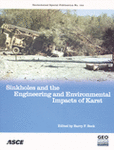Characterization and Water Balance of Internal Drainage Sinkholes
Publication: Sinkholes and the Engineering and Environmental Impacts of Karst
Abstract
Internal drainage microbasins were found constitute 10% of the 98 square km (38 square mile) portion of the Barton Springs segment of the Balcones Fault Zone Edwards Aquifer contributing to Barton Springs. Internal drainage basins have subtle geomorphological expressions that have historically been overlooked as a major recharge source within the Barton Springs segment. Internal drainage basins can be recognized and mapped based on large solution sinkhole bowls, internal contours on surface topographic maps, aerial photos, inspection of sinkholes during and after rain events, field delineation of catchment areas with GPS, and accounts from individuals such as property owners and cave explorers. We measured water balance components within a large internal drainage basin, the 19-hectare (46-acre) Headquarter Flat Sink to more directly quantify the amount of recharge contributed from internal drainage microbasins to the Edwards Aquifer. The monitored water balance components of HQ Flat that were measured for a year period (348 days), included the discrete recharge to the cave drain, evapotranspiration flux using an eddy covariance system mounted on a 15-meter tower, and soil moisture using insitu sensors and gravimetric analysis. Over the year test period, where rainfall totaled 106 cm, 58% left as evapotranspiration, 8% recharged directly through the cave drain, and 34% recharged diffusely across the internal microbasin of the cave site. The total recharge was measured to be 42% of the rainfall within the test basin. Only the discrete recharge portion was directly measured in a second internal drainage microbasin, the 22-hectare (54-acre) Hint Ridge Cave, since June 2003. The discrete recharge from Flint Ridge Cave was measured to be 9% over the same test year. During the 348-day test period, it can be estimated that known internal drainage basins contribution comprises about 5% of the Barton Springs flow reported by the USGS of 62,297,153 m3 (2,200,003,200 ft3). The water balance data from this study shows that internal drainage basins appear to be relatively efficient in recharging runoff for a given amount of source area because: 1) they do not lose runoff to areas downstream of the Recharge Zone; 2) naturally developed channels and bowls divert runoff rapidly into the subsurface; and 3) the recharge is typically limited to intervals during and shortly after rainfall events when the humidity is near saturation and net losses to evaporation are reduced. Recharge quantity can be significantly enhanced through preservation and restoration of flow to internal drainage basin sinkholes.
Get full access to this chapter
View all available purchase options and get full access to this chapter.
Information & Authors
Information
Published In
Copyright
© 2005 American Society of Civil Engineers.
History
Published online: Apr 26, 2012
Authors
Metrics & Citations
Metrics
Citations
Download citation
If you have the appropriate software installed, you can download article citation data to the citation manager of your choice. Simply select your manager software from the list below and click Download.
